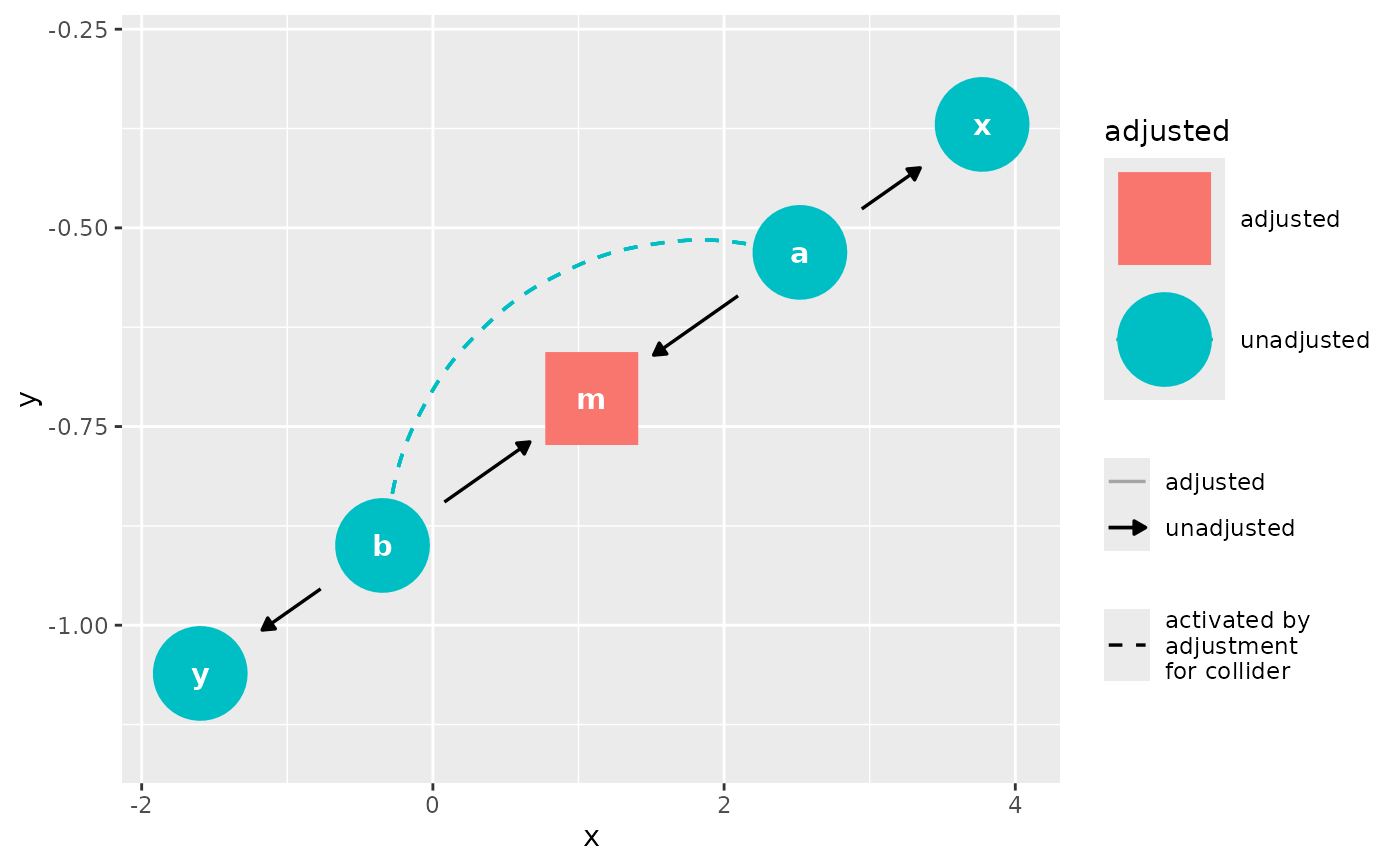
Adjust for variables and activate any biasing paths that result
Source:R/adjustment_sets.R
control_for.RdAdjust for variables and activate any biasing paths that result
Usage
control_for(.tdy_dag, var, as_factor = TRUE, activate_colliders = TRUE, ...)
adjust_for(.tdy_dag, var, as_factor = TRUE, activate_colliders = TRUE, ...)
ggdag_adjust(
.tdy_dag,
var = NULL,
...,
size = 1,
edge_type = c("link_arc", "link", "arc", "diagonal"),
node_size = 16,
text_size = 3.88,
label_size = text_size,
text_col = "white",
label_col = "black",
edge_width = 0.6,
edge_cap = 10,
arrow_length = 5,
use_edges = TRUE,
use_nodes = TRUE,
use_stylized = FALSE,
use_text = TRUE,
use_labels = FALSE,
label_geom = geom_dag_label_repel,
key_glyph = draw_key_dag_point,
text = NULL,
label = NULL,
node = deprecated(),
stylized = deprecated(),
collider_lines = TRUE
)Arguments
- .tdy_dag
A
tidy_dagittyordagittyobject- var
a character vector, the variable(s) to adjust for.
- as_factor
Logical. Should the column be a factor?
- activate_colliders
logical. Include colliders activated by adjustment?
- ...
additional arguments passed to
tidy_dagitty()- size
A numeric value scaling the size of all elements in the DAG. This allows you to change the scale of the DAG without changing the proportions.
- edge_type
The type of edge, one of "link_arc", "link", "arc", "diagonal".
- node_size
The size of the nodes.
- text_size
The size of the text.
- label_size
The size of the labels.
- text_col
The color of the text.
- label_col
The color of the labels.
- edge_width
The width of the edges.
- edge_cap
The size of edge caps (the distance between the arrowheads and the node borders).
- arrow_length
The length of arrows on edges.
- use_edges
A logical value. Include a
geom_dag_edges*()function? IfTRUE, which is determined byedge_type.- use_nodes
A logical value. Include
geom_dag_point()?- use_stylized
A logical value. Include
geom_dag_node()?- use_text
A logical value. Include
geom_dag_text()?- use_labels
A logical value. Include a label geom? The specific geom used is controlled by
label_geom.- label_geom
A geom function to use for drawing labels when
use_labels = TRUE. Default isgeom_dag_label_repel. Other options includegeom_dag_label,geom_dag_text_repel,geom_dag_label_repel2, andgeom_dag_text_repel2.- key_glyph
A function to use for drawing the legend key glyph for nodes. If
NULL(the default), the glyph is chosen automatically based on theunified_legendsetting. When provided, this overrides the automatic selection. Common options includedraw_key_dag_point,draw_key_dag_combined, anddraw_key_dag_collider.- text
The bare name of a column to use for
geom_dag_text(). Ifuse_text = TRUE, the default is to usename.- label
The bare name of a column to use for labels. If
use_labels = TRUE, the default is to uselabel.- node
Deprecated.
- stylized
Deprecated.
- collider_lines
logical. Should the plot show paths activated by adjusting for a collider?
Value
a tidy_dagitty with a adjusted column for adjusted
variables, as well as any biasing paths that arise, or a ggplot
Examples
dag <- dagify(m ~ a + b, x ~ a, y ~ b)
control_for(dag, var = "m")
#> # DAG:
#> # A `dagitty` DAG with: 5 nodes and 4 edges
#> # Paths opened by conditioning on a collider: a <-> b, a <-> b, a <-> b, a <-> b
#> #
#> # Data:
#> # A tibble: 11 × 9
#> name x y direction to xend yend collider_line adjusted
#> <chr> <dbl> <dbl> <fct> <chr> <dbl> <dbl> <lgl> <fct>
#> 1 a -2.79 0.602 -> m -1.35 0.777 FALSE unadjusted
#> 2 a -2.79 0.602 -> x -4.04 0.448 FALSE unadjusted
#> 3 b 0.0868 0.953 -> m -1.35 0.777 FALSE unadjusted
#> 4 b 0.0868 0.953 -> y 1.34 1.11 FALSE unadjusted
#> 5 m -1.35 0.777 NA NA NA NA FALSE adjusted
#> 6 x -4.04 0.448 NA NA NA NA FALSE unadjusted
#> 7 y 1.34 1.11 NA NA NA NA FALSE unadjusted
#> 8 a -2.79 0.602 <-> b 0.0868 0.953 TRUE unadjusted
#> 9 a -2.79 0.602 <-> b 0.0868 0.953 TRUE unadjusted
#> 10 a -2.79 0.602 <-> b 0.0868 0.953 TRUE unadjusted
#> 11 a -2.79 0.602 <-> b 0.0868 0.953 TRUE unadjusted
#> #
#> # ℹ Use `pull_dag() (`?pull_dag`)` to retrieve the DAG object and `pull_dag_data() (`?pull_dag_data`)` for the data frame
ggdag_adjust(dag, var = "m")
